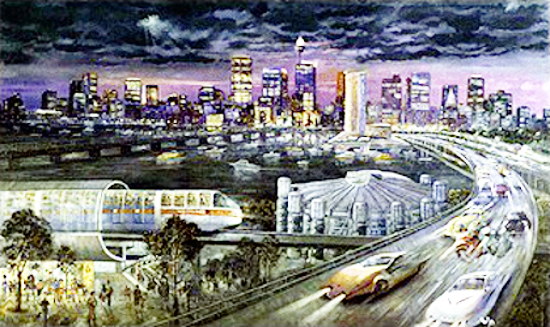Project Description
1988-2008
This painting shows the latest addition to Sydney’s landmarks in 1988 – the new Darling Harbour. Instead of an ugly industrialised wharf area, it was transformed into a seaside recreation centre.
Some of the developments of the time are pictured. On the left is Pyrmont Bridge. Carrying the monorail, one of its stations was on the western foreshore of Darling Harbour. To the right is the Convention Centre on the Pyrmont side and the Hotel-Casino complex on the city side, a proposal which was not accepted by the government and thus never built. Also on the right is the North Western Freeway, which continues into the city to join the Western Distributor and connects with the Bradfield Highway (which crosses the Sydney Harbour Bridge).
Construction work for the refurbishment of the classical Pyrmont Bridge – a landmark which was preserved for posterity – began at the end of 1987. Its swing-span continues to operate to allow ships up to 15 metres high to enter and moor in the inner harbour. The old bridge, opened in June 1902, had an electrically operated swing mechanism. After complete restoration. the bridge has become a walkway with panoramic views of the city.
Dominating the bottom left of the painting is the Convention Centre Station, seen here with a monorail just leaving it. Known as the TNT Harbour-Link, it linked the Darling Harbour complex with the city centre, encouraging Sydneysiders and tourists alike to enjoy a quick, convenient and scenic ride to the various attractions which Darling Harbour has to offer. The route, a loop configuration, was 3.6 kilometres long, with three city and five Darling Harbour stations. The round trip took about 12 minutes, with the monorail cruising at a speed of around 33km/hr. Each monorail (consisting of seven individual cars) was about 32 metres long and there were six in total. Completely pollution-free and whisper-quiet (due to rubber tyres and electric motors), it was claimed to be the most effective and efficient device from moving people within the inner-city.
Seven storeys high and sculptured into a vast enfolding curve, the Convention Centre dominates the western foreshore. With an imposing glassed eastern facade mirroring the waters of Darling Harbour and the city skyline by day, and its surrounding phalanx of columns blazoning intertwined spirals of light at night, it was more like a Roman amphitheatre. The centre’s Plenary Hall, with a capacity of 3,500 people, was the largest of its kind in the Southern Hemisphere. The futuristic building was destined to become Australia’s leading venue for trade fairs such as boat and motoring shows as well as international Expos. Over 700 tonnes of structural steel was made into sections for the skeleton of this massive structure, equal in size to five football fields.
